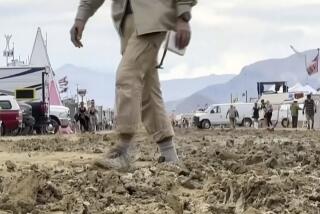U.S. Troops Face Added Challenge--the Desert : Mideast crisis: Soldiers threatened by Iraq’s army and the threat of chemical weapons must also endure searing heat and a lack of water.
- Share via
WASHINGTON — U.S. troops in Saudi Arabia are defending America’s oil lifeline in the harshest of environments: searing heat, vast desert expanses and the horrifying threat of poison gas attacks.
The thousands of American soldiers and airmen who began landing on the Arabian Peninsula on Wednesday could face a battle-hardened, million-man Iraqi army. But the desert itself is a formidable foe.
The heat alone can be defeating. Temperatures in August often top 120 degrees.
Even without the physical strain of combat, U.S. soldiers in Saudi Arabia will have to drink at least six gallons of water a day while their bodies adjust to the climate, an Army planner said.
Besides the dangers of exhaustion and dehydration, the heat also hurts the U.S. troops’ ability to cope with the threat of a chemical attack by Iraq.
Maj. Joe Padilla, an Army spokesman at the Pentagon, said the soldiers heading to Saudi Arabia are equipped with gear to defend against a chemical attack. This includes protective clothing, such as boots, gloves, masks and special trousers and jackets.
They are also carrying special sensing devices, including battery-operated devices that sample the air for indications of poisonous gas, as well as medicines to counteract the effects of exposure to chemical agents, officials said.
The protective gear inhibits a soldier in the best of climates. In the heat of the Saudi desert, the clothing would take an especially heavy toll, Padilla said.
Padilla said all soldiers routinely are trained in chemical protective measures but that most are exposed only to a simulated chemical attack.
The harsh climate, combined with the vast, nearly featureless open spaces of the Saudi desert, present extraordinary problems for soldiers’ ability to hide from the enemy.
CHEMICAL WARFARE
Chemical warfare, used several times by Iraqi troops in the war with Iran, has been banned by international treaty since World War I. some type of these chemicals can kill or disable an enemy in seconds. One particularly deadly from can kill if a drop the size of a pinhead touches the skin. Battle Dress for Chemical Warfare:
Mask: Basic (M-17) mask; protects from all known chemical and biological vectors in vapor form through the use of filters-one of each side of the cheek. Filters are replaceable.
Over-garment: A two-piece suit which protects against contact with chemical and biological toxin agents and radioactive particles. The outer layer is made of nylon and cotton. The inner layer is charcoal-impregnated polyurethane foam. Once the suit has been used it is discarded rather than decontaminated.
Gloves: Made of impregnable black butyl rubber; whom with inner cotton gloves for perspiration absorption.
Over-boot: Green vinyl slipped over combat boots.
How a Binary Artillery Shell Works: The binary shell contains two components which form to make nerve gas. These components are harmless as long as they do not mix. The components are kept in individual canisters and inserted into the shell just before firing. Once the shell is fired, the flight and spin causes the liquid in the canisters to mix. After traveling a safe distance, it explodes and the mixed gases spread.
More to Read
Sign up for Essential California
The most important California stories and recommendations in your inbox every morning.
You may occasionally receive promotional content from the Los Angeles Times.













